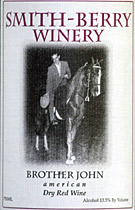In This Issue• Locavino |
Locavino
We've heard a lot lately about "locavores," people who try to limit their menu as much as possible to natural foods from local producers, shunning food made far away that must travel many "food miles" to reach your table.
It's fairly easy to do this with food in most parts of the world, But if you don't live in Northern California, Italy or France or other great world wine region, it's a lot harder to be a ... let's call it "locavino."
I'm lucky to live in a region that for much of the year is rich in local produce. But the Ohio Valley isn't known for its wine, or at least it hasn't been since the early 1800s when the poet Longfellow spoke lyrically of Ohio's Catawba wine.
What's a wannabe locavino to do? Personally, I'm not about to give up my international favorites, even if it means I have a wine-carbon footprint the size of the Southern Rhone.
Still, it's worth remembering that wine is hot nowadays, and you'll find at least a few local wineries in almost any part of Earth's temperate zones, including all 50 American states and much of Canada, and such seemingly unlikely European locations as Denmark and Sweden.
With summer at hand, it's always fun to take a road trip. With gasoline at $4 per gallon, there's never been a better time to investigate a winery close to home.
Although wineries in the Eastern U.S. and Canada generally haven't earned a lot of respect, times are changing. As local producers gain expertise and their vineyards mature, Eastern wineries - some of them anyway - are turning out very good wine. Most of them sell their product only at the winery or through limited local retailers, so to learn what's good around you, there's no better way than hitting the local wine road.
One of my favorite local wineries is Smith-Berry in Henry County, Ky., in the scenic rolling farm country not far south of the Ohio River between Louisville and Cincinnati. Owners and wine makers Chuck Smith and Mary Berry-Smith started making wine commercially a few years ago, and awards soon followed. Chuck's wife, Mary, is the daughter of the philosopher-poet Wendell Berry and niece of the respected lawyer and former State Senator John Berry, a family connection that has helped spread their reputation in the Bluegrass and beyond.
I recently tasted one of their small-production wines, named "Brother John" after John Berry, who is shown on horseback on the wine label. Minimally labeled a non-vintage "American Dry Red Wine" under the complicated U.S. appellation laws, it's actually a 2005 Syrah made from grapes grown in Arkansas, plus a splash of Kentucky Chambourcin.
Despite this odd pedigree, it's a very fine Syrah indeed, with ripe flavors, grilled-meat and smoke nuances and a full-bodied flavor that remind me in a way of a fine California Syrah but also evokes a good Northern Rhone Syrah.
It's a fine effort. Though it will be hard for those outside Kentucky or Southern Indiana to find, I encourage you to devote a summer weekend to discovering your own local wine roads, wherever you may live.
Smith-Berry Winery non-vintage "Brother John" American Dry Red Wine ($18.99)

Very dark garnet. Fresh, fruity cherry-berry scent with subtle notes of smoke and meat, typical ripe Syrah. Mouth-filling and ripe, juicy black fruit and tart acidity, well structured with soft tannins. Very nicely put together at a rational 13.5% alcohol, with characteristics that will appeal both to lovers of ripe California Syrah and structured Northern Rhone Syrah. (June 11, 2008)
FOOD MATCH: Grilled beef would be a splendid companion, but we had no complaints with a couple of thick, juicy pan-seared locally grown pork chops.
VALUE: Wine-Searcher.com shows an unusually wide range of prices on this wine, from the lower teens to $20. It's a particularly good buy at the lower end of this range.
WHEN TO DRINK: It should be good for several years, although the slick-sleeve artificial cork mitigates against long cellaring. Wine maker Chuck Smith says he plans to switch to high-quality natural cork for his high-end wines.
WEB LINK: Click here for the winery Website, with information about the winery, the family and contacts.
http://www.smithberrywinery.net
FIND THIS WINE ONLINE:
As is often the case with small, Eastern wineries, Smith-Berry wines are made in small amounts and are available only at the winery and a few nearby wine shops. (For Louisville-area buyers, The Wine Rack on Frankfort Avenue is a good source.) Also, use the Web link above to contact the winery for information.
Talk About Wine Online
If you have questions, comments or ideas to share about today's article
or wine in general, you're always welcome to drop by our online
WineLovers Discussion Group. This link will take you to the forum home page, where you can read discussions in all the forum sections:
http://www.wineloverspage.com/forum/village
Everyone is free to browse. If you'd like to post a comment, question or reply, you must register, but registration is free and easy. Do take care to register using your real name, or as a minimum, your real first name and last initial. Anonymous registrations are quietly discarded.
To contact me by E-mail, write wine@wineloverspage.com. I'll respond personally to the extent that time and volume permit.
PRINT OUT TODAY'S ARTICLE
Here's a simply formatted copy of today's Wine Advisor, designed to be printed out for your scrapbook or file or downloaded to your PDA or other wireless device.
http://www.wineloverspage.com/wineadvisor2/
2008/06/locavino-print.html




